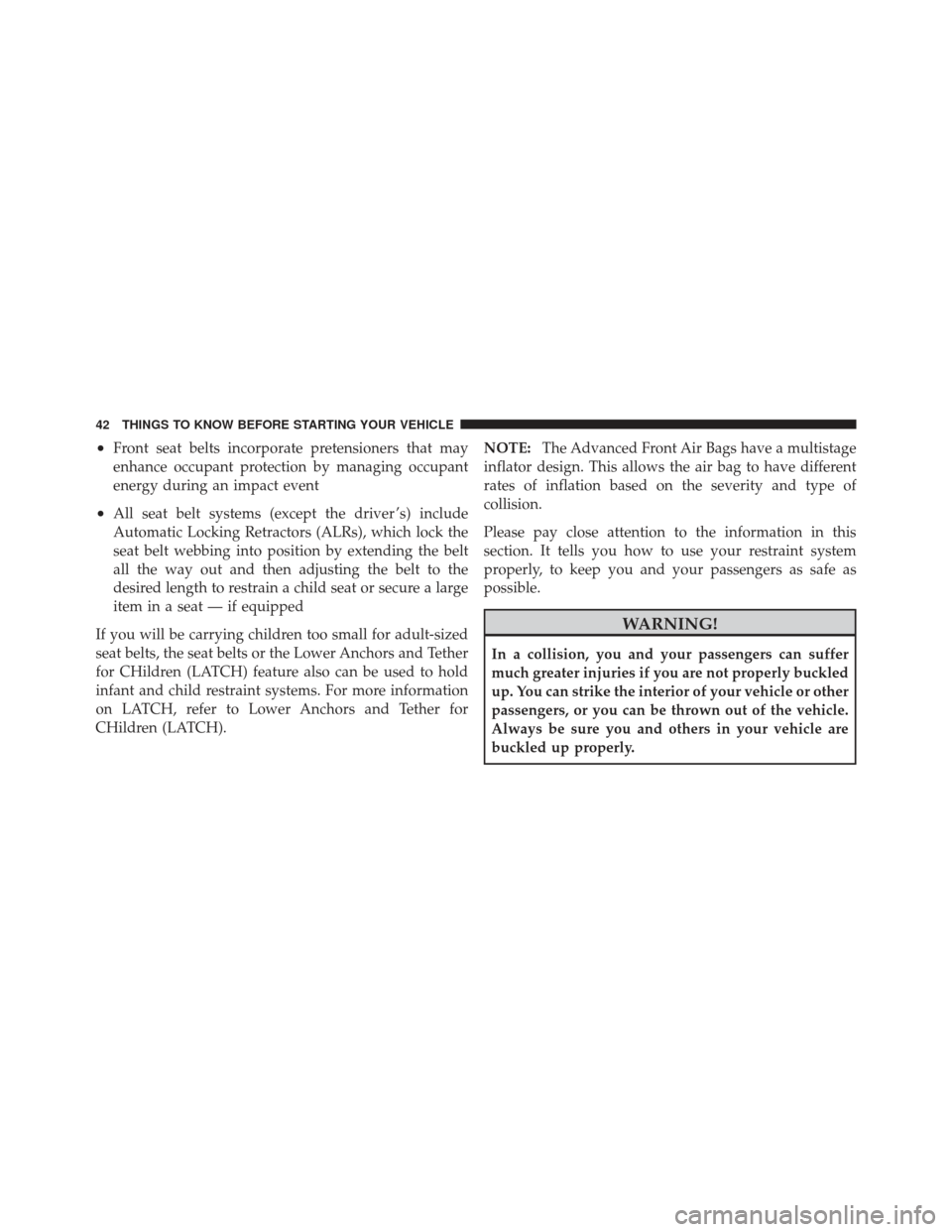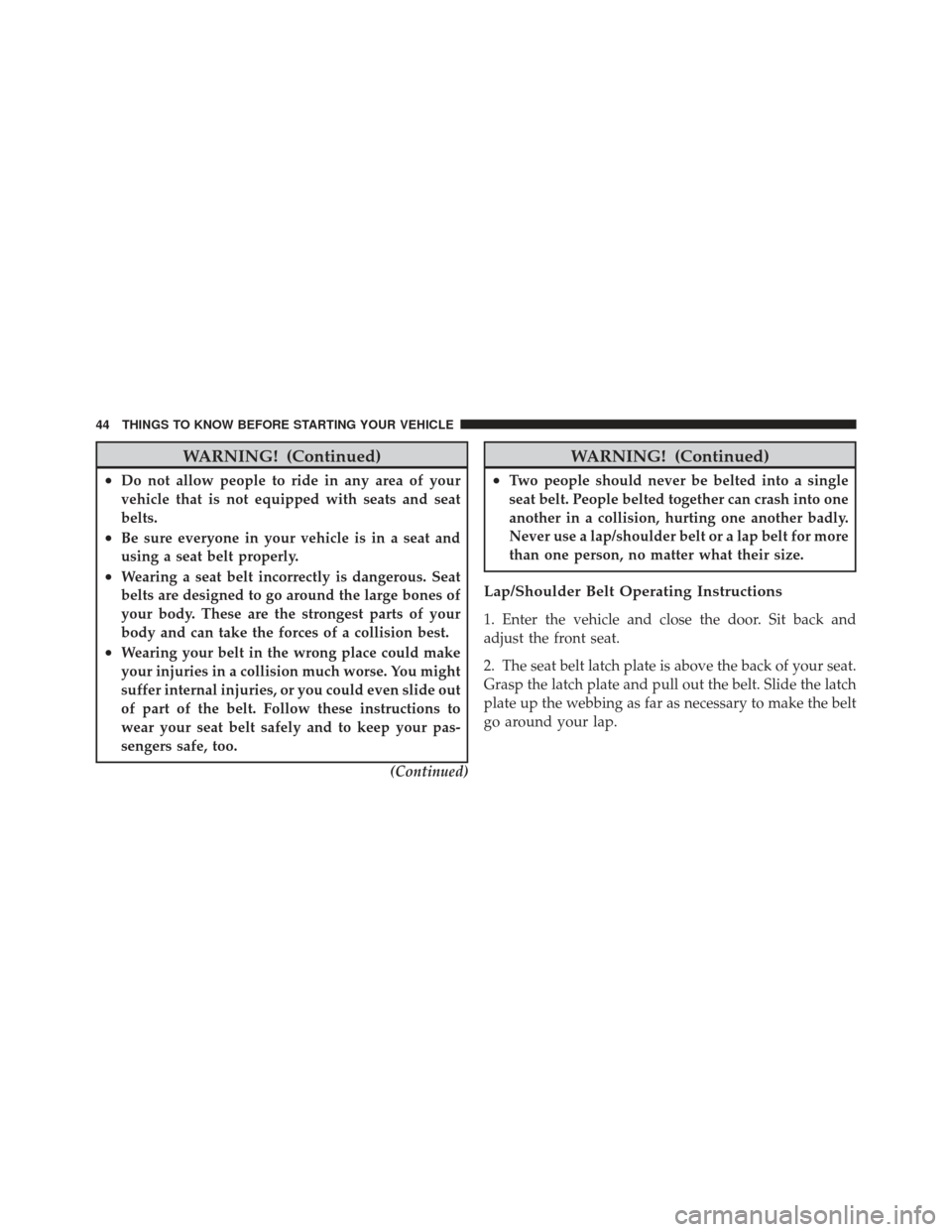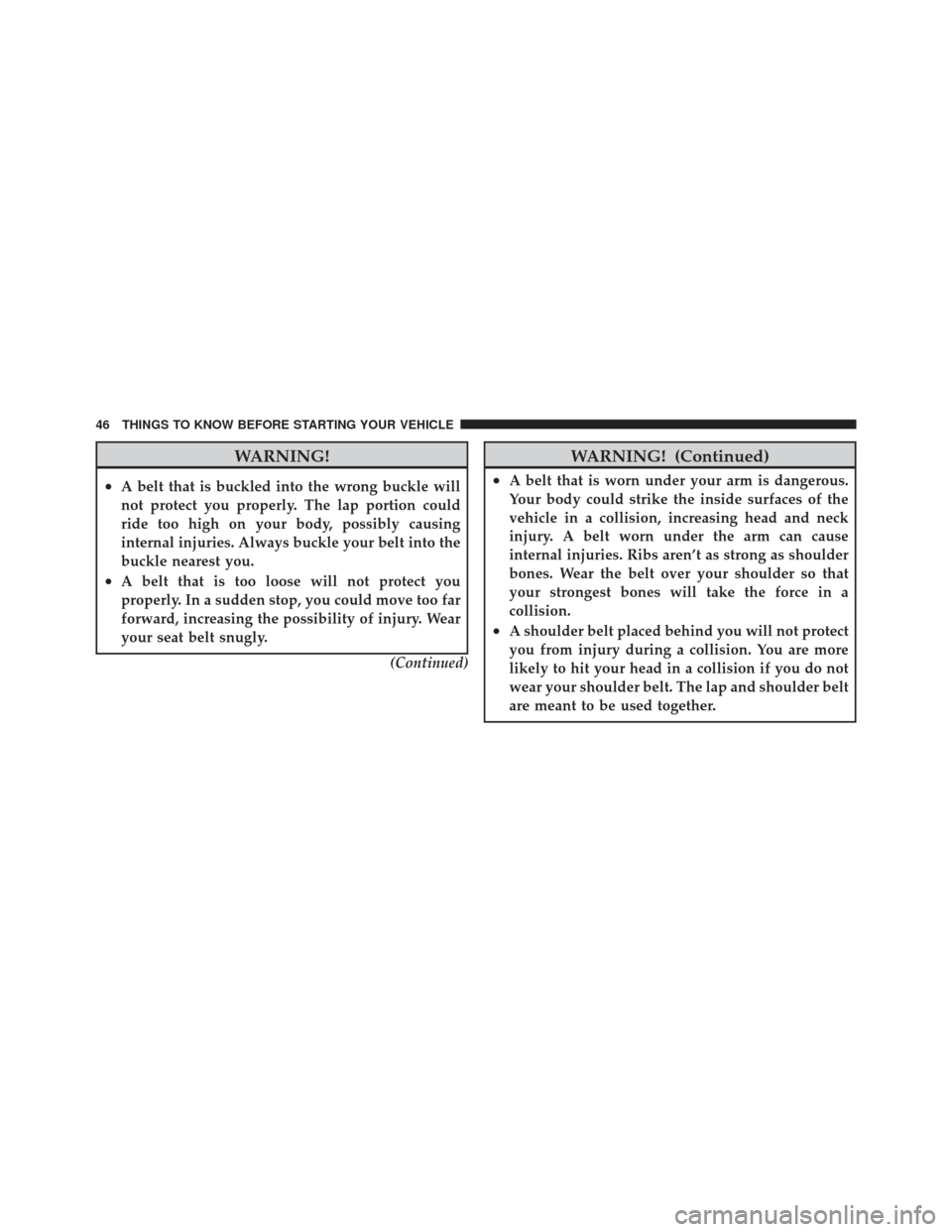Page 12 of 594

▫Using The Panic Alarm ................. 23
▫ Programming Additional Transmitters ...... 23
▫ Transmitter Battery Replacement .......... 24
▫ General Information ................... 25
� Remote Starting System — If Equipped ....... 25
▫ How To Use Remote Start ............... 26
� Door Locks ........................... 28
▫ Manual Door Locks ................... 28
▫ Power Door Locks .................... 29
▫ Child-Protection Door Lock System — Rear
Doors ............................. 31
� Keyless Enter-N-Go ..................... 32 �
Windows ............................ 36
▫ Power Windows ...................... 36
▫ Wind Buffeting ....................... 39
� Trunk Lock And Release ................. 39
� Trunk Safety Warning ................... 40
▫ Trunk Emergency Release ............... 41
� Occupant Restraints ..................... 41
▫ Lap/Shoulder Belts .................... 43
▫ Lap/Shoulder Belt Untwisting Procedure .... 49
▫ Seat Belts In Passenger Seating Positions ..... 49
▫ Automatic Locking Retractor Mode (ALR) —
If Equipped ......................... 50
▫ Energy Management Feature ............. 51
10 THINGS TO KNOW BEFORE STARTING YOUR VEHICLE
Page 13 of 594
▫Seat Belt Pretensioners ................. 51
▫ Enhanced Seat Belt Use Reminder System
(BeltAlert�) ......................... 52
▫ Seat Belts And Pregnant Women .......... 53
▫ Seat Belt Extender ..................... 53
▫ Supplemental Restraint System (SRS) — Air
Bags .............................. 54
▫ Air Bag Deployment Sensors And Controls . . . 62
▫ Event Data Recorder (EDR) .............. 69▫
Child Restraints ...................... 70
� Engine Break-In Recommendations .......... 81
� Safety Tips ........................... 82
▫ Transporting Passengers ................ 82
▫ Exhaust Gas ......................... 82
▫ Safety Checks You Should Make Inside The
Vehicle ............................. 83
▫ Periodic Safety Checks You Should Make
Outside The Vehicle ................... 85
2
THINGS TO KNOW BEFORE STARTING YOUR VEHICLE 11
Page 43 of 594
Trunk Emergency Release
As a security measure, a trunk internal emergency release
lever is built into the trunk latching mechanism. In the
event of an individual being locked inside the trunk, the
trunk can be simply opened by pulling on the glow-in-
the-dark handle attached to the trunk latching mechanism.
OCCUPANT RESTRAINTS
Some of the most important safety features in your
vehicle are the restraint systems:
•Three-point lap and shoulder belts for the driver and
all passengers
•Advanced Front Air Bags for driver and front passen-
ger
•Supplemental Driver Side Knee Air Bag
•Supplemental Side Air Bag Inflatable Curtains
(SABIC) for the driver and passengers seated next to a
window
•Supplemental Seat-Mounted Side Air Bags (SAB)
•An energy-absorbing steering column and steering
wheel
•Knee bolsters/blockers for front seat occupantTrunk Emergency Release
2
THINGS TO KNOW BEFORE STARTING YOUR VEHICLE 41
Page 44 of 594

•Front seat belts incorporate pretensioners that may
enhance occupant protection by managing occupant
energy during an impact event
•All seat belt systems (except the driver ’s) include
Automatic Locking Retractors (ALRs), which lock the
seat belt webbing into position by extending the belt
all the way out and then adjusting the belt to the
desired length to restrain a child seat or secure a large
item in a seat — if equipped
If you will be carrying children too small for adult-sized
seat belts, the seat belts or the Lower Anchors and Tether
for CHildren (LATCH) feature also can be used to hold
infant and child restraint systems. For more information
on LATCH, refer to Lower Anchors and Tether for
CHildren (LATCH). NOTE:
The Advanced Front Air Bags have a multistage
inflator design. This allows the air bag to have different
rates of inflation based on the severity and type of
collision.
Please pay close attention to the information in this
section. It tells you how to use your restraint system
properly, to keep you and your passengers as safe as
possible.
WARNING!
In a collision, you and your passengers can suffer
much greater injuries if you are not properly buckled
up. You can strike the interior of your vehicle or other
passengers, or you can be thrown out of the vehicle.
Always be sure you and others in your vehicle are
buckled up properly.
42 THINGS TO KNOW BEFORE STARTING YOUR VEHICLE
Page 45 of 594

Buckle up even though you are an excellent driver, even
on short trips. Someone on the road may be a poor driver
and cause a collision that includes you. This can happen
far away from home or on your own street.
Research has shown that seat belts save lives, and they
can reduce the seriousness of injuries in a collision. Some
of the worst injuries happen when people are thrown
from the vehicle. Seat belts reduce the possibility of
ejection and the risk of injury caused by striking the
inside of the vehicle. Everyone in a motor vehicle should
be belted at all times.Lap/Shoulder Belts
All seating positions in your vehicle are equipped with
lap/shoulder belts.
The belt webbing retractor is designed to lock during
very sudden stops or impacts. This feature allows the
shoulder part of the belt to move freely with you under
normal conditions. However, in a collision, the belt will
lock and reduce your risk of striking the inside of the
vehicle or being thrown out.
WARNING!
•It is dangerous to ride in a cargo area, inside or
outside of a vehicle. In a collision, people riding in
these areas are more likely to be seriously injured
or killed.(Continued)
2
THINGS TO KNOW BEFORE STARTING YOUR VEHICLE 43
Page 46 of 594

WARNING! (Continued)
•Do not allow people to ride in any area of your
vehicle that is not equipped with seats and seat
belts.
•Be sure everyone in your vehicle is in a seat and
using a seat belt properly.
•Wearing a seat belt incorrectly is dangerous. Seat
belts are designed to go around the large bones of
your body. These are the strongest parts of your
body and can take the forces of a collision best.
•Wearing your belt in the wrong place could make
your injuries in a collision much worse. You might
suffer internal injuries, or you could even slide out
of part of the belt. Follow these instructions to
wear your seat belt safely and to keep your pas-
sengers safe, too.(Continued)
WARNING! (Continued)
•Two people should never be belted into a single
seat belt. People belted together can crash into one
another in a collision, hurting one another badly.
Never use a lap/shoulder belt or a lap belt for more
than one person, no matter what their size.
Lap/Shoulder Belt Operating Instructions
1. Enter the vehicle and close the door. Sit back and
adjust the front seat.
2. The seat belt latch plate is above the back of your seat.
Grasp the latch plate and pull out the belt. Slide the latch
plate up the webbing as far as necessary to make the belt
go around your lap.
44 THINGS TO KNOW BEFORE STARTING YOUR VEHICLE
Page 47 of 594
3. When the belt is long enough to fit, insert the latch
plate into the buckle until you hear a “click.”
Pulling Out The Lap/Shoulder Belt Latch PlateInserting Latch Plate Into Buckle
2
THINGS TO KNOW BEFORE STARTING YOUR VEHICLE 45
Page 48 of 594

WARNING!
•A belt that is buckled into the wrong buckle will
not protect you properly. The lap portion could
ride too high on your body, possibly causing
internal injuries. Always buckle your belt into the
buckle nearest you.
•A belt that is too loose will not protect you
properly. In a sudden stop, you could move too far
forward, increasing the possibility of injury. Wear
your seat belt snugly.(Continued)
WARNING! (Continued)
•A belt that is worn under your arm is dangerous.
Your body could strike the inside surfaces of the
vehicle in a collision, increasing head and neck
injury. A belt worn under the arm can cause
internal injuries. Ribs aren’t as strong as shoulder
bones. Wear the belt over your shoulder so that
your strongest bones will take the force in a
collision.
•A shoulder belt placed behind you will not protect
you from injury during a collision. You are more
likely to hit your head in a collision if you do not
wear your shoulder belt. The lap and shoulder belt
are meant to be used together.
46 THINGS TO KNOW BEFORE STARTING YOUR VEHICLE